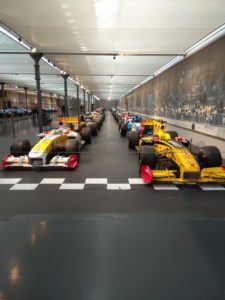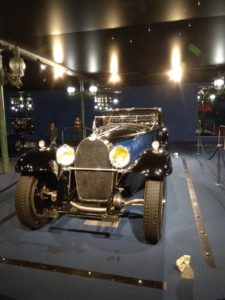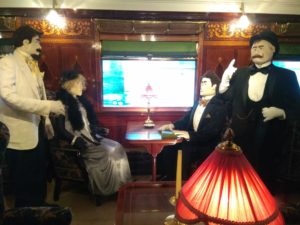Alsace, a region located on the eastern border of France close to Germany and Switzerland, is a magical place full of surprises. In this new series, we will take you to this very special place and give you a taste of the many wonders it has to offer.
By Alessandra Ivaldi / 5.02.2020
The second article of our new series is dedicated to the exploration of Alsace, focuses on two places in particular. We are still in Mulhouse, which was presented in the first article. If you still haven’t heard of this surprising French city, wait no longer! Just click on the link below to discover the “French Manchester”!
http://meetinghalfway.eu/2019/12/esploriamo-lalsazia-mulhouse/
Among the many attractions on offer in this city, two museums are really a mus-seen: the Cité de l’Automobile and the Cité du Train.
 The Cité de l’Automobile. The first of the two attractions on our virtual tour is the most important car museum of the world and presents a surprising history. It contains an impressive collection of prestigious cars. Even the least experienced visitor cannot help but admire the grandeur of the world’s most famous car manufacturers and discover the evolution of this fundamental means of transport, from its origins to the fastest and most technological cars of modern society.
The Cité de l’Automobile. The first of the two attractions on our virtual tour is the most important car museum of the world and presents a surprising history. It contains an impressive collection of prestigious cars. Even the least experienced visitor cannot help but admire the grandeur of the world’s most famous car manufacturers and discover the evolution of this fundamental means of transport, from its origins to the fastest and most technological cars of modern society.
At the root of this amazing collection lies the unbridled passion for cars of the two brothers Fritz and Hans Schlumpf, who gave life to a textile industrial empire in Mulhouse between 1935 and 1976. Fritz, the younger brother, secretly started to buy historical cars, establishing contacts with sellers from all over Europe and even from America. His secret collection grew rapidly and was kept hidden in the warehouse of an industrial establishment. Only a few privileged people were allowed to see it. Later, even Hans started to devote himself to the collection of prestigious cars, to the extent that the two brothers spent a significant portion of their riches expanding their collection and employing staff highly specialized in car restoration.
In the 1970s the two brothers decided to reveal to the media the existence of their amazing collection  and to inaugurate their future car museum in a spectacular way. Everything was ready for the opening of this new attraction, but the two brothers could never witness the realization of their dream. In fact, around that time their industrial empire fell into a crisis. The two brothers lost their entire fortune and had to close their factories and fire all the workers. These discovered the existence of the collection of prestigious cars in 1977, in conjunction with the “mediatic surprise” planned by the Schlumpf brothers in order to promote their own museum. The consequences were really unexpected for the two brothers: the workers got control of the collection and opened it to the public. It was in this way that the “Museum of workers” (in French, Musée des travailleurs), with free entry, was born. After long legal proceedings, the French government acquired the precious collection and re-sold it to the National Automobile Museum Association (Association du Musée national de l’automobile), founded with the aim of preserving Schlumpf’s cars and keeping them in Alsace. In 1982 the National Automobile Museum was finally inaugurated.
and to inaugurate their future car museum in a spectacular way. Everything was ready for the opening of this new attraction, but the two brothers could never witness the realization of their dream. In fact, around that time their industrial empire fell into a crisis. The two brothers lost their entire fortune and had to close their factories and fire all the workers. These discovered the existence of the collection of prestigious cars in 1977, in conjunction with the “mediatic surprise” planned by the Schlumpf brothers in order to promote their own museum. The consequences were really unexpected for the two brothers: the workers got control of the collection and opened it to the public. It was in this way that the “Museum of workers” (in French, Musée des travailleurs), with free entry, was born. After long legal proceedings, the French government acquired the precious collection and re-sold it to the National Automobile Museum Association (Association du Musée national de l’automobile), founded with the aim of preserving Schlumpf’s cars and keeping them in Alsace. In 1982 the National Automobile Museum was finally inaugurated.
Some years later, in 1989, Fritz Schlumpf obtained permission from the Paris Court of Appeal to rename the museum ‘Musée national de l’automobile – Collection Schlumpf’ (National Automobile Museum – Schlumpf Collection). Its current name, Cité de l’Automobile, was created in 2006, when the museum was entirely renovated. Today those who visit this place can admire the amazing collection of the Schlumpf brothers, divided in different areas based on the chronological classification of the many car models, and take a close look at the most prestigious racing cars of all time. In addition to all this, enthralling interactive exhibitions, representations and 3D movies are there to illustrate the functioning of many different kinds of car engines, while two real industrial robots show visitors how cars are constructed today. There are also parts of the museum which are absolutely not to be missed for children: a children’s area and a little electric train which allows visitors to explore Schlumpf’s huge collection in rapid speed. Moreover, it is possible to observe a series of wonderful toy cars for children; objects from the past able to make us all dream – not only the children, but the adults too! At certain parts of the year, visitors will even see Schlumpf’s prestigious cars come back to life and race in the so called autodrome, a running track inside the museum.

La Cité du Train
The Cité du Train. Equally fascinating is the Cité du Train, the biggest railway museum of Europe. It contains more than a hundred vehicles and a vast collection of objects connected with railway history. Here visitors can take a close look, or even discover from the inside, trains of all sorts: steam, electric and diesel locomotives… And they can also find out how future trains will be and the incredible speeds they will reach!
In the first area of the museum visitors will experience real time travel! In semidarkness, in a location which cannot but impress anyone who enters this place, stand a multitude of trains and coaches from the past, dating from the second half of the 19th century to the period after the Second World War. And by following some specific thematic itineraries, it is possible to investigate different aspects of railway history, from the lux of the aristocrats with their

Hercule Poirot
sumptuous coaches to the misery of the poorer social classes, to the emotion of the first holidays permitted to the workers, to end up with the horror of war. Life-sized mannequins, who play the role of railwaymen or of the passengers, enhance the feelings experienced by visitors at this place where different historical periods meet.
Speaking of mannequins, the famous detective Hercule Poirot of course should make an appearance! He is on board of the Orient Express, together with the other characters of the unforgettable novel by Agatha Christie, Murder on the Orient Express.
Proceeding with your visit, you will then find a more illuminated area, where it is possible to observe the functioning of different kinds of engines and obviously to further investigate the history of this iconic means of transport.
Think you can’t drive a steam train yourself? Think again. In fact, visitors have the opportunity to “drive a train” on rails running along the perimeter of the museum, which in the past were actually used for the normal transit of trains.



Recent Comments